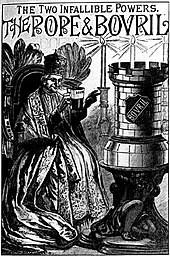利用者:Nissy-KITAQ/ボブリル
 Bovril (250 g 瓶) | |
| 考案者 | ジョン・ローソン・ジョンストン |
|---|---|
| 発売開始年 | 1889年 |
| 会社名 | Bovril Company |
| 販売元 | ユニリーバ |
ボブリル(英語: Bovril)は酵母エキスに似た濃厚で塩辛い精肉エキスのペーストで、登録商標でもある。1870年代にジョン・ローソン・ジョンストン(John Lawson Johnston)によって開発された。特有の球根状の瓶に詰めて販売されているほか、キューブや顆粒の製品も販売されている。英国ユニリーバが商標・販売権を保有しており、その見た目はイギリスのマーマイトやオーストラリアのベジマイトと類似している。
ボブリルはお湯や(お湯ほど一般的でないが)ミルクで薄めることでイギリスで「ビーフティー」と呼ばれる飲料となる[1]。またマーマイトやベジマイトのようにスープやだし、煮込み料理、ポリッジの調味料として使うことができ、また特にトーストなどの食品に塗って食することもできる[2]。
語源
[編集]
「ボブリル」という商品名の“bov”の部分はラテン語で「雄牛」を意味するbovīnusに由来する[3]。また“-vril“という接尾詞はエドワード・ブルワー=リットンが1871年に発表し、当時著名であった小説”The Coming Race“からジョンストンが採用したものである。この小説は”Vril”という電磁的物質に由来する力を持った“Vril-ya”という高等種族をめぐる内容で、つまり「ボブリル」は雄牛から得られた偉大な力を指すことになる[4]。
歴史
[編集]

普仏戦争さなかの1870年のこと、ナポレオン3世は兵士を養うために百万もの牛肉の缶詰を発注した[5]。この業務を請け負ったのはカナダに住むスコットランド人の肉屋であるジョン・ローソン・ジョンストン(John Lawson Johnston)であった[5]。大量の牛肉は英国の支配地域や南アメリカから調達することができたが、問題は輸送と保管であった。そのためジョンストンはナポレオン3世の需要に応えるために、のちにボブリルと呼ばれる「ジョンストン液状牛肉」('Johnston's Fluid Beef)として知られる製品を開発した[6]。1888年までに、3000以上のイギリスのパブ、食料品店、そして薬剤師(dispensing chemist)がボブリルを販売した。1889年に、ジョンストンのビジネスを拡大するためにボブリル株式会社(Bovril Ltd)が結成された[7]。
ボーア戦争におけるレディスミス包囲のさなか、駐屯地の中で馬肉を使ったボブリルようのペーストが製造された。これは馬やラバの肉をゼリー状に精製した「Chevril」(「ボブリル」と「馬」を意味する“cheval”のかばん語)と呼ばれ、ビーフティーのようにして提供された[8][9]。またボブリル株式会社はこの戦争のあいだイギリス軍のレーションとして、濃縮されたぺミカン状の乾燥肉を製造した。この戦闘糧食はポケットサイズのスズ製の缶の中に半分は乾燥肉、もう半分には乾燥ココアが入っており、乾燥肉はそのまま食べることが可能であるほか、水と混ぜてビーフティーを作ることもできた[10]。
ボブリルは第一次世界大戦でも「戦争食」としての機能を持ち続け、作家ヘレン・ゼンナ・スミス(Helen Zenna Smith)が1930年に発表した“Not So Quiet: Stepdaughters of War”という記述文でも頻繁に言及されている。作中にはベルギーのモンスで傷病兵のためにボブリルが準備される様子が登場し、「傷病兵を病院に輸送している際に輸送係と救急車が爆撃されたとき、ちょうど雑用係が傷病兵のためにボブリルを作り始めたところであった」とある[11]。
またボブリルのビーフティーは1914年から1917年に帝国南極横断探検隊として派遣されたエンデュランス号のアーネスト・シャクルトンの探検隊がエレファント島で遭難した際、彼らが飲むことができた唯一の温かい飲み物であった[12]。
ジョンが亡くなると、彼の息子であるジョージ・ローソン・ジョンストンが会社を引き継いだ。1929年に、彼は男爵(Baron Luke, of Pavenham)に叙された。
1966年にはインスタントのビーフストックが発売され、1971年には(要出典)シチューやキャセロール、グレイビー用の「King of Beef」という商品も発売された。1971年にはJames Goldsmith's Cavenham Foodsがボブリル社を買収し、乳製品や南アメリカ関連の事業は資金面の理由で売却された。現在、「ボブリル」ブランドは2001年に当社を買収した(6)ユニリーバによって保持されている。
When John Lawson Johnston died, his son George Lawson Johnston inherited and took over the Bovril business. In 1929, George Lawson Johnston was made Baron Luke, of Pavenham, in the county of Bedford.
Bovril's instant beef stock was launched in 1966 and its "King of Beef" range of instant flavours for stews, casseroles and gravy in 1971.[要出典] In 1971, James Goldsmith's Cavenham Foods acquired the Bovril Company but then sold most of its dairies and South American operations to finance further take-overs.[13] The brand is now owned by the Anglo-Dutch multinational Unilever, which bought Bovril in 2001.[6]
ボブリルは教皇と広告に現れたことでも特に知られている。20世紀初め英国のとある広告キャンペーンには玉座に座ったレオ13世がボブリルの注がれたマグを持った姿で描かれており、スローガンには「二つの不滅の力…教皇とボブリル」とある。
Bovril holds the unusual distinction of having been advertised with a Pope. An advertising campaign of the early 20th century in Britain depicted Pope Leo XIII seated on his throne, bearing a mug of Bovril. The campaign slogan read: The Two Infallible Powers – The Pope & Bovril.
ライセンス生産
[編集]ボブリルは南アフリカにおいてはパイオニアフーズのボコモ部門において生産されている[14]。
レシピの変更
[編集]2004年に、ユニリーバはボヴリルの製法から牛肉原料を除外し、ベジタリアンのものに変更した。これはベジタリアンの広がり、宗教的な食の要望に加えて牛海綿状脳症(いわゆる「狂牛病」)の蔓延によって英国牛肉の輸出が禁止されたことによって売り上げの低下が懸念されたことによるものであった(14)。その後輸出禁止が解除され、ボブリルの売り上げも上がったことを受けて、ユニリーバは2006年に決定を撤回し、牛肉の使用を再開した(15)。現在では牛エキスを使ったものと鶏エキスを使ったものがそれぞれ販売されている(16)。
In 2004, Unilever removed beef ingredients from the Bovril formula, rendering it vegetarian. This was mainly due to concerns about decreasing sales, particularly from exports due to an export ban on British beef, as a result of the growing popularity of vegetarianism, religious dietary requirements, and public concerns about bovine spongiform encephalopathy.[15] In 2006, Unilever reversed that decision and reintroduced beef ingredients to their Bovril formula once sales increased and the beef export bans were lifted.[16] Unilever now produces Bovril using beef extract and a chicken variety using chicken extract.[17]
また入れる
In November 2020, Forest Green Rovers Football Club announced a collaboration with the makers of Bovril to create a beet-based version of Bovril to be sold at their New Lawn stadium, where meat-based products had been removed from sale some years prior.[18]
文化的重要性
[編集]

ボブリルは20世紀初期に「スーパーフード」として宣伝された。広告では薄めてビーフティーにする、朝のトーストに塗るといった食べ方が推奨されていた。ある広告ではインフルエンザに効果があるとさえ宣伝されていた(5)。
Bovril was promoted as a superfood in the early 20th century. Advertisements recommended people to dilute it into a tea or spread it on their morning toast. Some adverts even claimed that Bovril could protect one from influenza.[5]
ボブリルの瓶は考古学的な構成要素の一つとして一般的に発掘されている(19)。たとえばウスターシャーにあるノウルズ・ミル(Knowles Mill)で見つかっている。
Bovril jars are commonly excavated as part of archaeological assemblages, such as at Knowles Mill in Worcestershire.[19]
その発明以来、ボブリルは英国文化のアイコンの一つとなった。それはフットボール文化と関連付けられる。冬の間、英国のフットボールファンはスタジアムのテラスでビーフティーを楽しむ。サーモスの魔法瓶に入れてきたビーフティーを飲む人もいるし、スタジアムへのサーモス魔法瓶の持ち込みが禁止されているスコットランドでは使い捨てコップで楽しむ(20)(21)。
Since its invention, Bovril has become an icon of British culture. It is associated with football culture. During the winter British football fans in stadium terraces drink it as a tea from Thermos flasks – or from disposable cups in Scotland, where thermoses are banned from football stadiums.[20][21]
映画「In Which We Serve」においては、ダンケルクから救出された橋の上の将校たちに暖をとるための「多めのシェリー酒で溶いたボブリル」(Bovril rather heavily laced with sherry)が供されるシーンがある(要出典)。
In the film In Which We Serve, the officers on the bridge are served "Bovril rather heavily laced with sherry" to warm them up, after being rescued during the Dunkirk evacuation of the British Expeditionary Force.[要出典]
英国の登山家クリス・ボニントンは1970年代から1980年代に放映されたCMに出演しており、そのなかで温かい飲み物をつくるためにエベレストの雪や氷を溶かす様子を回想していた(要出典)。
British mountaineer Chris Bonington appeared in TV commercials for Bovril in the 1970s and 1980s in which he recalled melting snow and ice on Everest to make hot drinks.[要出典]
関連項目
[編集]脚注
[編集]- ^ “Try Bovril and milk (advert)”. The Sydney Mail: p. 23. (1 July 1931)
- ^ Wainwright, Martin. “Bovril drops the beef to go vegetarian”. The Guardian 28 May 2018閲覧. "In Malaysia they stir it into porridge and coffee"
- ^ OED entry at bovine.
- ^ Thompson, William Phillips (1920). Handbook of patent law of all countries. London: Stevens. p. 42 2009年8月5日閲覧。
- ^ a b c Wong, Cecily; Thuras, Dylan (2021). Gastro obscura : a food adventurer's guide. New York: Workman Publishing Company. p. 2. ISBN 9781523502196
- ^ a b “Bovril”. Unilever.co.uk. 12 October 2015閲覧。
- ^ “Money-Market and City Intelligence”. The Times (London) (32638): p. 12. (5 March 1889)
- ^ Watt, S. “Intombi Military Hospital and Cemetery”. Military History Journal (Die Suid-Afrikaanse Krygshistoriese Vereniging) 5 (6).
- ^ Jacson, M (1908). “II”. The Record of a Regiment of the Line. Hutchinson & Co.. p. 88
- ^ “1899-1902 British Emergency Ration Field Service Oldest MRE Beef Eaten Survival Food Review Test”. Template:Cite webの呼び出しエラー:引数 accessdate は必須です。
- ^ Vivian, Evelyn Charles (1914). With the Royal army medical corps (R.A.M.C.) at the front. Hodder and Stoughton. p. 99
- ^ “Shackleton's men kept hope of rescue high; Marooned Scientists, Living on Penguin and Seaweed, Watched Daily for Relief.”. The New York Times. (1916年9月11日). オリジナルの2022年10月9日時点におけるアーカイブ。 2009年5月11日閲覧。
- ^ “Goldsmith”. 5 January 2009時点のオリジナルよりアーカイブ。 Template:Cite webの呼び出しエラー:引数 accessdate は必須です。
- ^ “Pioneer Foods”. pioneerfoods.co.za. Template:Cite webの呼び出しエラー:引数 accessdate は必須です。
- ^ Wainwright, Martin (18 November 2004). “Bovril drops the beef to go vegetarian”. The Guardian. 1 March 2017時点のオリジナルよりアーカイブ。1 March 2017閲覧。
- ^ “Unilever puts the beef back into Bovril”. The Guardian (1 September 2016). 1 March 2017時点のオリジナルよりアーカイブ。1 March 2017閲覧。
- ^ “Bovril Unilever food brands”. 11 April 2012時点のオリジナルよりアーカイブ。 Template:Cite webの呼び出しエラー:引数 accessdate は必須です。
- ^ “Rovers bringing Bovril back”. Forest Green Rovers F.C (1 November 2020). 2 November 2020閲覧。
- ^ Halsted, Jon; Hewitson, Chris; Booth, Tim (2010). Knowles Mill, Wyre Forest, Bewdley, Worcestershire - Historic Building Recording, Archaeological Evaluation. Birmingham: Birmingham Archaeology. pp. 14–22
- ^ “Bovril: It's a drink, a spread, even a crisp flavouring, and it was created in Edinburgh”. The Scotsman (8 June 2010). 20 October 2013閲覧。
- ^ Alexander Lawrie (7 August 2009). “Tribute to Scots Bovril inventor”. Deadline News. 20 October 2013閲覧。
外部リンク
[編集]- Unilever Website
- Unilever explains the reintroduction of beef to Bovril.
- BBC: No beef over Bovril's veggie move
- The Bovril Shrine
- Documents and clippings about Nissy-KITAQ/ボブリル in the 20th Century Press Archives of the ZBW
